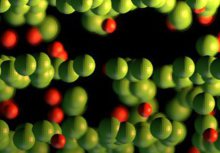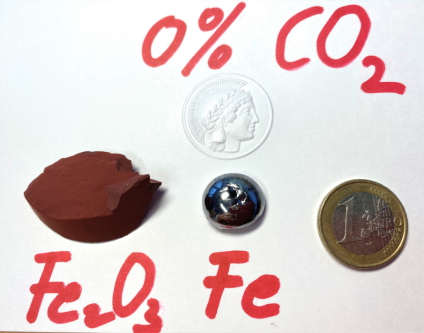Sustainable Steel Making: Hydrogen Plasma Smelting Reduction of Iron Ore
What is a plasma?
Plasma is one of the four fundamental states of matter, alongside solid, liquid, and gas. It is often described as an ionized gas, which means that it is composed of a mixture of free-moving electrons and ions—atoms or molecules that have lost or gained electrons and thus carry an electric charge. This ionization occurs because the energy levels in the plasma are sufficient to disassociate electrons from their atomic nuclei.
The properties of plasma are governed by electromagnetic forces since the components (electrons, ions) are charged particles. These particles interact through both long-range Coulomb forces and short-range forces when collisions occur. This interaction leads to unique behaviors not observed in neutral gases, such as high electrical conductivity, sensitivity to magnetic and electric fields, and the generation of collective oscillations known as plasma waves.
Plasma is created either by heating a gas until its electrons have sufficient energy to escape the attraction of their nuclei or by subjecting it to a strong electromagnetic field which strips electrons away—a process known as ionization. Common examples of plasma include stars (including our sun), lightning, neon lights, and the material in fluorescent bulbs.
In terms of temperature, plasma can exist in a wide range, from relatively cool (a few thousands of degrees Celsius, such as for instance used by our group for sustainable metallurgy) to extremely hot (millions of degrees Celsius), as found in fusion reactors and the cores of stars. The behavior of plasma is often described using the parameters of plasma physics, such as Debye length, plasma frequency, and gyro-radius, which help in understanding its interactions and dynamics.
What is a hydrogen-based plasma and why is that of interest in procesing, recycling and sustainable metallurgy?
Hydrogen-based plasma, primarily composed of ionized hydrogen atoms and ionized molecules —protons and free electrons—is one of the simplest and most ubiquitous types of plasma in the universe. This plasma forms under conditions where hydrogen atoms are ionized, either due to high temperatures or through electromagnetic fields.
The creation of hydrogen-based plasma is not limited to natural astrophysical phenomena like those found in stars. It can also be artificially generated in laboratory settings, particularly using devices such as plasma torches or in nuclear fusion research reactors like tokamaks. Here, hydrogen isotopes like deuterium and tritium are employed to explore fusion processes that may one day serve as powerful energy sources.
Hydrogen plasma is noted for its excellent electrical conductivity, a trait that arises from its highly ionized and thus very reactive state. This allows the plasma to efficiently conduct electricity and interact with electromagnetic fields, and participate in metallurgical (and other) redox reactions, making it highly adaptable to various technological applications, particularly in the field of sustainable metallurgy. The temperature of hydrogen plasma varies significantly depending on its use—from relatively mild temperatures in some industrial processes to the extreme conditions required for fusion energy production.
In industrial applications, the reactivity and high energy of hydrogen plasma are harnessed for a variety of critical processes. For instance, hydrogen plasma is used in plasma torches for cutting and welding materials, providing a clean and efficient method for handling metals, as well as for plasma based reduction of ores and dumped industry waste. Furthermore, it plays a pivotal role in the disposal of hazardous waste by breaking down complex molecules into safer, simpler forms. This capability of hydrogen plasma is also applied in the synthesis and processing of materials, where its reactive properties facilitate the engineering of advanced materials with specific characteristics.
Understanding and manipulating hydrogen-based plasma is therefore essential not just in theoretical physics and astrophysics but also in enhancing and innovating industrial processes. The exploration of hydrogen plasma continues to contribute to advancements in manufacturing, waste management, and energy production, underlining its versatility and importance in both natural and engineered systems.
Why reducing iron ore by hydrogen plasma?
Iron- and steelmaking is the largest single industrial CO 2 emitter, accounting for 8-8% of all CO2 emissions on the planet. This fact challenges the current technologies to achieve carbon-lean steel production and to align with the requirement of a drastic reduction of 80% in all CO 2 emissions by around 2050. Thus, alternative reduction technologies have to be implemented for extracting iron from its ores. The hydrogen-based direct reduction has been explored as a sustainable route to mitigate CO2 emissions, where the reduction kinetics of the intermediate oxide product FexO (wüstite) into iron is the rate-limiting step of the process. The total reaction has an endothermic net energy balance. Reduction based on a hydrogen plasma may offer an attractive alternative. Here, we present a study about the reduction of hematite using hydrogen plasma. The evolution of both, chemical composition and phase transforma- tions was investigated in several intermediate states. We found that hematite reduction kinetics depends on the balance between the initial input mass and the arc power. For an optimized input mass-arc power ratio, complete reduction was obtained within 15 min of exposure to the hydrogen plasma. In such a process, the wüstite reduction is also the rate-limiting step towards complete reduction. Nonetheless, the reduction reaction is exothermic, and its rates are comparable with those found in hydrogen-based direct reduction. Micro- and nanoscale chemical and microstructure analysis revealed that the gangue elements partition to the remaining oxide regions, probed by energy dispersive spectroscopy (EDS) and atom probe tomography (APT). Si-enrichment was observed in the interdendritic fayalite domains, at the wüstite/iron hetero-interfaces and in the oxide particles inside iron. With proceeding reduction, however, such elements are gradually removed from the samples so that the final iron product is nearly free of gangue-related impurities. Our findings provide microstructural and atomic-scale insights into the com- position and phase transformations occurring during iron ore reduction by hydrogen plasma, propelling better understanding of the underlying thermodynamics and kinetic barriers of this essential process.
What is the challenge associated with green iron making?
Annually, 2.6 billion tons of iron ore (mostly hematite) are converted into steel by the integrated blast furnace (BF) and basic oxygen furnace (BOF) route, accounting for approximately 70% of the global steel production. The remaining 30% is realized by melting steel scraps and directly reduced iron (the latter is also referred to as sponge iron) in electric arc furnaces (EAF). On av- erage, about 2.1 tons of CO 2 are produced per ton of crude steel . This number corresponds to about 6.5% of all CO 2 emissions on the planet and makes iron- and steelmaking the largest in- dustrial individual emitter of CO 2. To mitigate global warming, a drastic reduction of 80% in all CO 2 emissions is targeted until 2050. Thus, disruptive technology changes in iron ore reduction must be urgently implemented, already within the next years.
What are alternative reduction methods for green and sustainable iron making?
The use of hydrogen instead of carbon for iron ore reduction is currently explored as an alternative sustainable route to miti- gate the CO 2 emissions. The direct reduction of iron ore pel- lets by pure molecular hydrogen above 570 °C occurs with the intermediate formation of other iron oxide variants, viz. Fe 2 O 3 (hematite) → Fe 3 O 4 (magnetite) → Fe x O (wüstite) → Fe (iron). Although the net energy balance of the overall process is endothermic, studies demonstrate that its reduction kinetics can be reasonably faster than that of commercial direct reduction conducted in shaft furnaces using reformed natural gas (e.g. the Midrex process). This observation motivates the current global investments in hydrogen-based direct reduction pilot plants.
Why is hydrogen plasma a viable alternative reduction method for green and sustainable iron making?
Hydrogen plasma offers a viable alternative for carbon-neutral iron making. Its high energy and enhanced density of H radicals and exited states help to overcome the reaction’s activation barrier and has the potential for enhancing the Fe x O reduction rates by an order of magnitude, enabling iron conversion to reach commercially viable rates. Also, hydrogen plasma-based reduction allows the production of liquid iron in one single step, in which the input fine ores are melted and reduced simultane- ously without the need for intermediate agglomeration or refine- ment processing, as the melting point of iron oxide (1565 °C) only slightly exceeds that of iron (1538 °C).
During the hydrogen plasma reduction (HPR), a plasma arc zone is generated between an electrode and the input iron ore (e.g. hematite). In this zone, the ore can be melted and re- duced by hydrogen in both molecular and plasma states. The lat- ter is composed of vibrationally ionized (H + , H 2 + and H 3 + ), ex- cited (H ∗) and atomized (H) species, which are formed through the mutual elastic and inelastic collisions of hydrogen particles with electrons. Under such conditions, the corresponding degree of hydrogen dissociation is determined by the competing ionization (e.g. e −+ H 2 → H 2 + + 2 e −) and recombination (e.g. H + + e −→ H) events. The high energy carried by the hy- drogen plasma is partially released at the reaction interface, gen- erating a large amount of local heat. This heat diminishes the need for external power supply and promotes high power- efficiency to the process. Thus, the thermo-kinetics advantages observed in HPR depend directly on the concentration of hydrogen plasma radicals that are able to reach the reaction interface.
Sustainable steel hydrogen plasma reduct[...]
PDF-Dokument [9.6 MB]



